
Published :
Updated :

“Where you are sitting now was my home long ago, until the river devoured it,” said the old man with a long, white beard, pointing at my brown plastic chair.
We were in a floating eatery in the northern Gaibandha district’s Phulchari Ghat, and underneath the floorboards gently flowed the Jamuna River. Behind me, the scarred riverbank was a testament to the degree of havoc that rising water levels and floods could wreak in the monsoon. As Jahidul harked back to how erosion had upended his life thrice, I asked him about the obsolete rail ferry service on the Jamuna that the Phulchari Ghat was famed for.
“Passengers from northern districts, including Dinajpur, would arrive here by train. They would board the steamer to reach Jamalpur’s Bahadurabad Ghat across the river and take another train to Dhaka. It was a very lively place,” the farmer recollected.
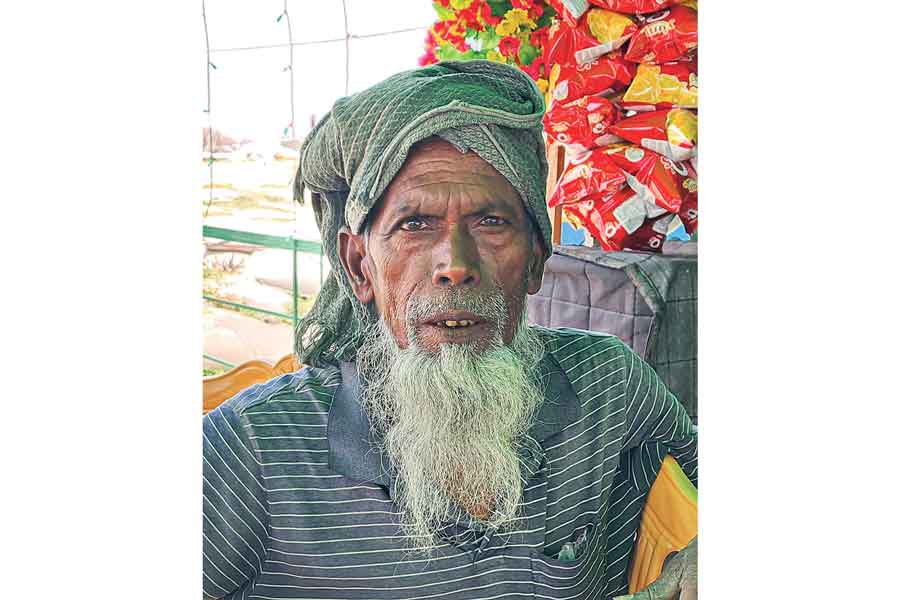
Local farmer Jahidul still remembers the glory days of the Phulchari Ghat in Gaibandha
The British had established this arrangement in 1938 as bridging the wide Jamuna, which divides the eastern and western parts of Bangladesh’s upper half, was an insurmountable problem back then. Steamers carried passengers, while ferries transported goods-laden wagons. It was a cheap way for northerners to travel to Dhaka, while the route also flourished as an economic corridor.
Following Jahidul’s directions, I walked in the riparian area and arrived at the once-bustling Phulchari Bazar, now a drab marketplace of some tin-roofed shops. Around the corner were tin shacks, built by low-income people engaged in agriculture and rearing livestock, on both sides of the abandoned rail tracks on the Phulchari-Bonarpara line. Several stretches of tracks lay buried underground, and another one remained precariously suspended in mid-air.
The path led to a rail bridge stretching over the Ghaghat River, a distributary of the Teesta. The rails on it had corroded and wooden sleepers rotted, reminiscent of the era when the bridge endured the pounding of thundering trains every day. Down in the river, near the edge of the water, some children bathed and frolicked.
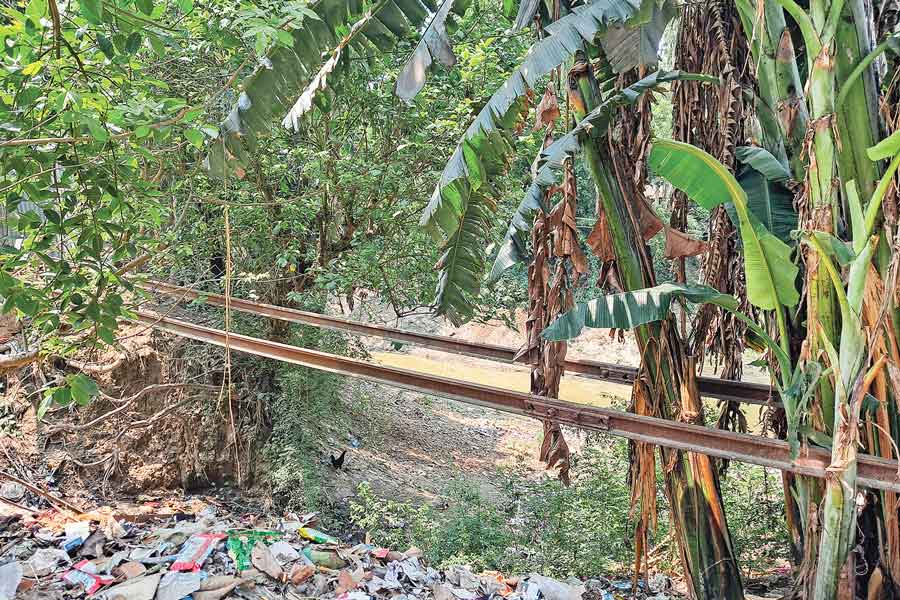
A stretch of track on the Phulchari-Bonarpara line remains precariously suspended mid-air
After reaching the Ullabazar rail gate, I met local journalist Mostafizur Rahman. He said Phulchari was a bustling transport hub, providing livelihoods for 200-300 coolies. There were 40-50 eateries, while some 1,000 railway employees worked in the whole of Gaibandha.
“The freight cars transporting sugar, wheat, fertiliser, and even mango from northern districts would arrive here and be loaded onto a barge, which had nine to 10 lines. Each line could accommodate three to four wagons. The barge would then be towed by a tugboat to Bahadurabad,” explained Mostafizur, whose father had worked at the terminal as an employee of the railway’s marine department.
He recalled taking homemade lunch to his father by boarding the train from the nearby Varotkhali station and hanging out with friends by the scenic riverside in the afternoon. The monsoon was a difficult period for coolies as the ground became slippery and muddy. Railway workers handling wagons also faced challenges, with many sustaining injuries.
Even wagons fell into the river several times. Mostafizur’s father had to pay 80 per cent of his salary in fines after such an incident. This was because the railway blamed it on a dereliction of duty by the employees.
Phulchari thrived until the Jamuna’s navigability crisis worsened, leading to the terminal’s relocation to Balashi in the same upazila after 1990. The crisis, which still persists, stems from the large number of sandbars, locally known as chars, in the river. Originating in the Himalayas and entering Bangladesh through Kurigram, the Jamuna is a highly braided river comprising multiple shifting channels that weave around the chars.
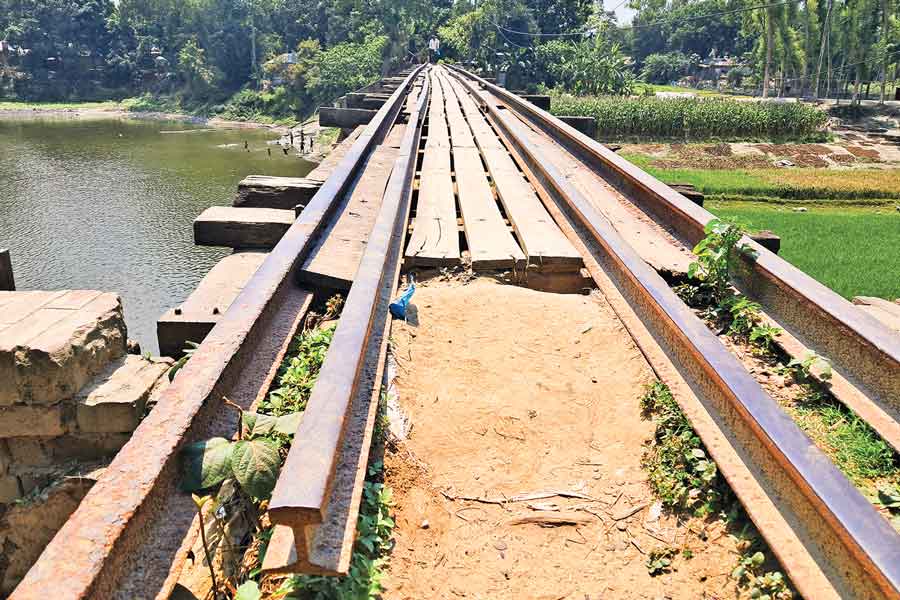
Rails on the disused bridge on the Ghaghat River have corroded and wooden sleepers rotted
The massive sediment load that it carries from the Himalayas is deposited in the riverbed, forming chars that appear and disappear with seasonal variations in water flow. The strong currents during monsoon rains and floods erode riverbanks and inundate many chars. The eroded materials, combined with new sediment from upstream, are deposited again in other places, forming fresh chars.
The Balashi Ghat was as vibrant as Phulchari. But it began losing its lustre when the Jamuna Bridge opened in 1998 as northerners chose to travel directly to Dhaka by bus. Merchandise was still ferried, but that also stopped gradually, and the ferry fleet was auctioned in stages.
After bidding Mostafizur adieu, I stayed the night in a budget hotel across the Gaibandha municipal park and took an auto-rickshaw to Balashi in the morning. What remained of the terminal’s legacy was a floating landing station to get on and off boats and some tin-roofed shops, including tea stalls. An elderly shopkeeper named Abdur Rahman said the place draws many visitors in the afternoon and evening.
Google Maps showed rail tracks in the riverside area, but I found only rural life - modest houses, livestock, and haystacks. Proceeding further, I encountered village doctor Titu Mia Mithu, who said tracks on the Trimohini-Balashi line, a branch of the Santahar-Kaunia route, had been removed in 2023. Recalling the Balashi Ghat’s vibrant past, he said a coolie’s daily earnings potential was Tk 1,000, while many people from northern districts opened shops and earned good money.

Low-income people have built tin shacks on both sides of the abandoned rail tracks on the Phulchari-Bonarpara line
“The Balashi Ghat, where I even saw foreigners, is now a desert,” he stressed.
He also explained why the authorities’ attempts to revive the ferry route had failed despite establishing a new terminal. Two modern terminals built in Balashi and Bahadurabad had been inaugurated in 2022, but full-fledged passenger launch or goods ferry services could not be started because of the same navigability crisis. Shallow engine-powered wooden boats, which fall short of the required safety standards, remain the only means to reach Bahadurabad. Buying a ticket for Tk 300, I got on a packed boat where two motorbikes were also loaded. Reaching mid-river, I saw chars all around that stretched for miles and looked like misplaced islands, significantly narrowing the river and obstructing its flow. Even after an hour, I saw chars where horse-drawn carts transported people and children played in sandpiles.
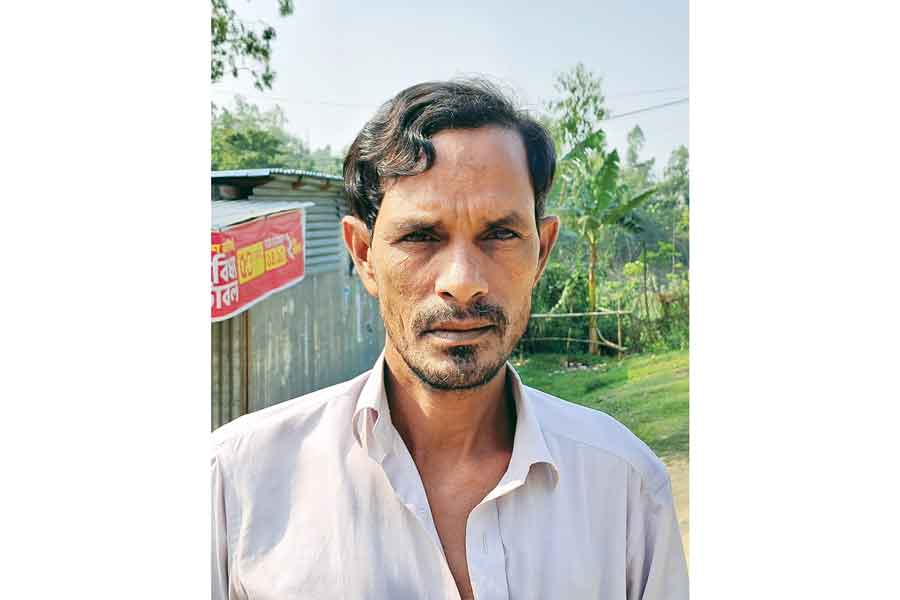
Local village doctor Titu Mia Mithu says the vibrant Balashi Ghat is now a desert
Trouble struck suddenly when the helmsman unknowingly steered into a shallow channel near a char. The engine sputtered and stopped, alarming passengers. But both the nonchalant boatmen manoeuvred the boat with long bamboo poles to get back to a navigable stretch.
Though I was scared when the boat got stuck, I experienced the gravity of the Jamuna’s navigability crisis firsthand. If this small boat ran aground, how would massive rail ferries ply? Several years ago, a Bangladesh Inland Water Transport Authority committee’s inspection found that ferries were not viable on this historic route due to poor navigability.
“The boat tells you where the water is shallow and where it is deep. Yet, we hit a shallow channel. Such channels are sometimes difficult to identify," Phul Mia, one of the boatmen with dusty hair, said. Sitting on a box near the engine, he occasionally moved the tiller, his eyes fixed on the horizon. Serving the route for many years, he had seen two passengers fall overboard and drown.
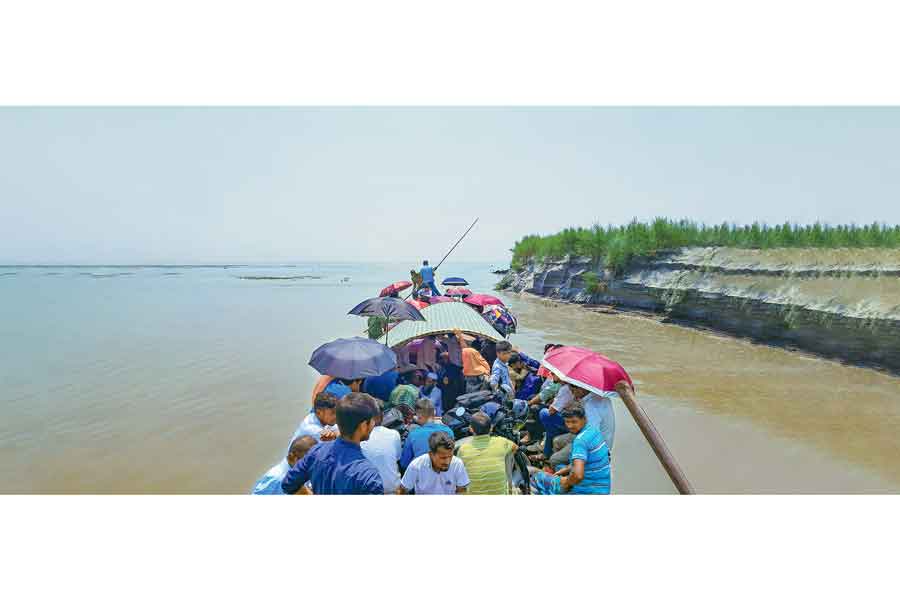
Shallow engine-powered boats now carry passengers on the defunct Balashi-Bahadurabad rail ferry route
I gazed at the passengers sitting on both edges as the boat advanced, leaving a wake that did not spread widely in the murky water. If a powerful storm began suddenly and made the journey perilous, Phul said he would moor in the shallow water near a char and wait for the tempest to subside. With several passengers putting up umbrellas to shield themselves from the blazing sun under a clear, bluish sky, he asserted that such a calamity was highly unlikely.
Patches of clouds filled parts of the sky as we approached our destination, with the waterside still looking like a char. The Bahadurabad Ghat resembled Balashi - faded yet alive, with easy bikes lined up to take boat passengers to the nearby Dewanganj Bazar, the present terminus of the trains from Dhaka. Looking back at the river, I felt that the boat had transported me not just from one riverbank to another, but from the present into a distinct chapter of Bangladesh Railway’s history, and then back again.


 For all latest news, follow The Financial Express Google News channel.
For all latest news, follow The Financial Express Google News channel.